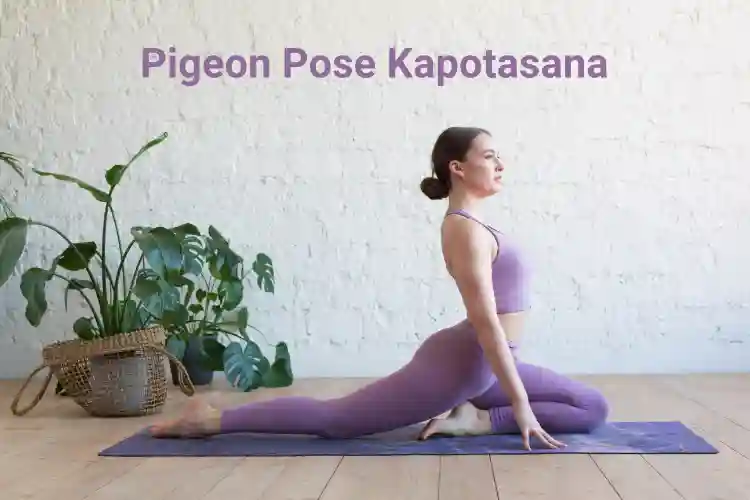Flex Your Hips With Pigeon Pose (Kapotasana)

Are you feeling the stress in the lower torso? The hips muscles are stiff, and you find it difficult to walk. Then Yoga might have a solution for this. Yoga has a variety of ranges that can target the body organs specifically for their betterment. We are going to study hip openers. Don’t go by literal meaning. This yoga poses help to modulate the hip movement and increase the external or outward rotation of the femur bone in the hip socket. Few other logic poses help to lengthen the Psoas muscle connecting the torso and the legs that gets chronically shortened due to our chair-bound society. One such Yoga technique is the Pigeon Pose Kapotasana. It is one of the most effective hip opener techniques that focus on the front and back leg.
Pigeon pose is a variation of Eka Pada Rajakapotasana (One-Legged King Pose). There is a start similarity between the two poses in terms of the hip alignment and approach. There are two schools of thought, one recognising that the one-legged king pigeon pose is an advanced backbend that requires exact alignment. Others think they should fold into the forward bend variation of Pigeon. The latter pose puts stress on the knee and sacrum. So it is important to open the hips gradually, smoothen the mobility and then position yourself for the perfect pigeon pose. This will ultimately balance your hips and lower spine. This pigeon position will help in easy movement while you walk, sit or stand. The stiffness of the hip will go. Let us go through the significance of this pigeon pose.
Table of Content
Why Is The Significance of Kapotasana Pose?
This hip opener pose works on the lower torso. The forward bend helps in stretching the thighs, groin, back and Psoas. The Psoas and the hip flexors stretch due to the extension of the leg. While on the outside, the outer rotators and the outer hip muscles are stretched. This posture helps you get ready for seated postures like sukhasana, padmasana and backbends like the cobra pose or the cow pose. This pose acts as a tranquilizer to the side effects of sitting pose for a long duration. Few of the yoga experts claim that the pose helps in toning the spinal region by smoothening the blood circulation around the spine. This also helps in keeping the secondary sexual organs healthy since it stretches the pelvic region. These claims are unverified, and more scientific research is needed. Let us know the procedure to perform the Pigeon pose.
How To Perform The Pigeon Pose?
The pose is considered to be tough for some. If you are not comfortable bending forward and flexing your hip muscle, then you should avoid it. However, if you are an experienced yoga practitioner then, taking the downward dog facing pose can help you in achieving the Pigeon pose. Consult your expert for correct posture. Let us see the instructions in detail.
- Press your fingers on the floor in a forward seated position. Bring forward your right knee towards the corresponding wrist. Depending on the body type, the position of the knee can be either behind the wrist or on either side edge of the wrist. Try with whichever position you are comfortable with your knees. The main motive is that the outer hip should be stretched without actually discomforting the knee.
- The position of the right ankle will be in front of the left hip. The left leg should be stretched backwards, with the toe pointed downwards, and the heel should face upwards.
- The two hips should be in a scissor position by drawing the legs in towards each other. If you are not comfortable, then put support below the right buttock. Take a deep breath, concentrate on the fingertips and erect the spine and push the navel in and open the chest outwards.
- Slowly exhale and extend your hands forward and bend your body towards the floor. Rest your upper torso on the mat. Try this for 5 breaths or more as per your comfort. One each exhalation, release the tension in the right hip.
- Finally, to release the pose, push back with the support of hands, elevate your hips and move your back left leg to its original position and repeat that with your right leg as well.
Few suggestions for beginners. There are a few modifications and variations that may help beginners. This pose calls for an intense stretch of the outer hip muscles. One can keep the right foot close to the left hip to start with. If you are not able to bend the forehead to the level of mat, then you can use a block and rest your head on it. Having said that, never try to perform this pose on your own. Take help from an expert in the beginning. Call Yoga experts and find out which variation suits you.
Modifications And Variations
The modification includes a backbend by keeping the arms straight and lifting the chest. There is a figure four version. Sit with the knees flexing forward and feet flat on the floor. The arm should be behind your hip position for support. Bring the right ankle over the left knee. The foot should be flexed enough. Stretch the left foot closer to the hip. This can be done lying on the back also.
Benefits Of Pigeon Pose
As already mentioned, this is a hip-opening pose; it will increase the mobility of the hip. This helps in balancing the hip level and strengthening the hip muscles. Most of the yoga poses calm the mind and this one also does the same. It targets the stretching of the Psoas muscles, and hip flexors. It also helps prepare the body for backbends and seated position. Some also believe that it helps in relieving mental stress and worry. Now let us know when not to use the Pigeon pose.
Pigeon Pose Contraindications
Sometimes more than knowing, it is necessary to know when not to use the Yoga pose. This pose demands too much tension of knee and hip muscles and joints. So be very cautious about your knee; any kind of sensation or tingling feeling should be an indication of not performing the pose. In case the knee hurts, then bring the right foot closer to the left hip. Any kind of stretch that gives you pain should be avoided. Sacroiliac issues like ankylosing spondylitis, sacroiliitis, arthritis or sciatica are contraindications for not using this pose. Also, it should be avoided during pregnancy. Take medical aid and consult your doctor.
Pigeon pose is kind of a forward bend. This is a class of yogic poses. There are three versions of the Pigeon pose, and the former has to be mastered in order to move forward. This version is the first stage or the beginner’s phase. Next will come to the Mermaid pose and the last one is the one legged king pigeon that is the full pigeon pose. Spend time on getting comfortable with each of the positions before moving forward. Do not forget to consult a yoga expert before starting any yoga pose. Yoga has more health benefits than side effects only if it is done in the correct way.
You may also like:-
What is Mandukasana (Frog Pose)?
What Exactly Does Makarasana Imply?
Trikonasana (Triangle Pose)- Importance, Benefits, and Variations
















